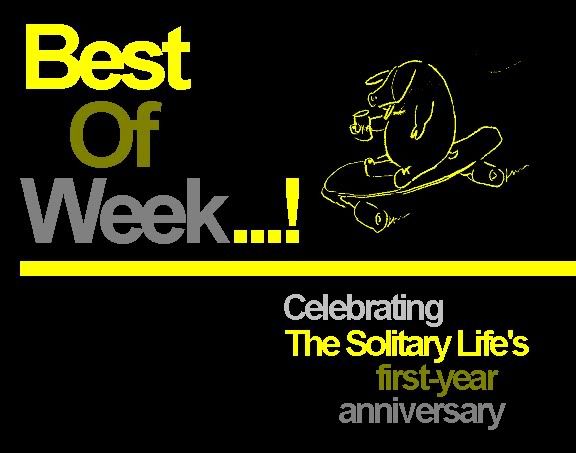
One of the most fun, and most significant things that we did this year was to dedicate September as our first-ever "Freestyle Month" here at The Solitary Life. That was a wise decision on our part. And we'd like to sincerely thank the entire freestyle community for being a part of it.
One of the most touching things that I heard this year, was how happy The Freestyle Community was that we actually take the time to give freestyle skating regular (monthly, to be exact), thorough, and dedicated coverage. What's more: Our very-first staffer (AJ Kohn) was brought on board, right from Day One, specifically for this reason. To give freestyle skating the regular, thorough, and dedicated coverage that we thought it deserved all along.
Yet: I've never freestyled a day in my entire life. So, what the fuck gives?!
Here's what the fuck gives: It doesn't matter what I personally do, or even what I personally think. Any sort of publication that claims to serve "The Greater Good of Skateboarding"... whether it's an online publication, a print magazine, or anything else... ultimately needs to step their shit up, and make decisions that actually serves The Greater Good of Skateboarding, and serves it well.
Covering freestyle (regardless of my personal inexperience with it) was a solid step in what I thought was ultimately, the right direction to take. In the name of The Greater Good of Skateboarding.
This particular article was originally dumped onto AJ's lap. AJ of course being our freestyle correspondent, that was a perfectly logical assignment to dole out. However: At the time, AJ was way busy organizing the World Championships of Freestyle in Philly (which we also covered). So, I ended up taking this one on myself. Even though I didn't know the first fucking thing about the history of freestyle.
But: Where other heads see nothing but roadblock, I tend to see nothing but opportunity. In this case, the opportunity to learn something myself, for a change. And learn, I did. This article was the net result of about nine months of solid research. In the course of all that research, here's what I learned:
1. Everybody's essentially a freestyler.
2. Freestyle is truly the basis of everything that we do, today. As such:
3. Today's freestyle is tomorrow's mainstream.
If you doubt me on this? Check out Kilian Martin's newest YouTube clip, go home, and cry yourself to sleep tonight. Because most kids (and pros, I might add) are going to see this as the end of their sponsor-me rock-star dreams.
But, the rest of us will see it for what it is: The dawn of a whole new era in creative thinking, and stylish doing. And once again: All brought to us by a tiny handful of freestylers.
Watch history repeat itself all over again...
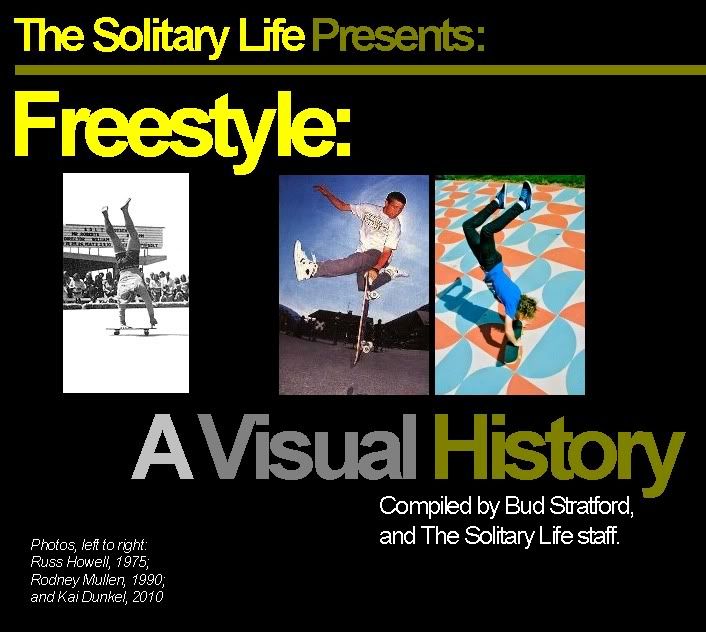
Before I begin this freestyle retrospective piece, I wanted to say how happy I am that "Freestyle Month" at The Solitary Life has finally arrived...! I'm so stoked. Because, it's gonna be a great month. I can feel it, man...
A few months back, we made the announcement that we wanted help from the freestyle community, to write a brief "History Of Freestyle" for September. Of course, skaters being skaters, nobody responded. Figures. The only help that we got was from our resident freestyle reporter, AJ Kohn. But even he was relatively tied up with organizing The World Championships of Freestyle... which are right around the corner! Those are happening on September 18th & 19th in Philadelphia, and we're absolutely gonna be there. We wouldn't miss it for the world... no pun intended.
So... why freestyle? The fact is, if you know anything at all about skateboarding's history... most kids don't, but whatever... you'll understand that freestyle is the basis for all "modern" skateboarding. Almost everything that you're doing on the street, today (as well as, much of what you're doing on vert, in skateparks, et cetera) was a direct result of the freestyle movement of the 1970's, 1980's, and through to today.
Let's take a look at just one example: The Ollie. Which is the building block upon which most of "modern" skateboarding is built. Invented by Alan Gelfand in 1978, the "original" ollies were done by scooping the tail off of the protruding coping of the era's concrete skatepark bowls. But, it took some time for skaters to figure out how to "pop" the tail off of flat ground, which is where the "Ollie" truly transformed the fundamentals of skateboarding. The skaters that "perfected" the Ollie, were freestylers. And skateboarding has never been the same since.

Counterclockwise, from top left: Alan Gelfand fires the first shot in the coming aerial war; Rodney and the flatground ollie snatch the cover of Thrasher, underscoring their contributions to things to come; the inventors, Mr. Mullen and Mr. Gelfand; and, The Mutt snapping up a flatground ollie-to-indy. Notice how he popped it off the nose, to avoid the plastic skidplate on the tail.
Today, most of "the industry" views freestyle as a relic of a bygone era, a neon and grotesquely flamboyant stepchild of the 1980's. However, "The Industry" has proven itself to be pretty damned clueless on a whole lot of issues as of late, and this one is no different. The truth is that freestyle continues to progress and promote itself just under the surface of "mainstream" skateboarding. And given the evolutions that are going on, I see no reason why the freestylers of today won't continue to influence the rest of skateboarding, tomorrow.
These "evolutions" don't stop at the simple progression of tricks, either. Parallel evolutions in the realm of film (Brett Novak), promotions and contests (AJ and The Worlds, obviously), personal style and longevity (Kevin Harris), and creativity (Killian Martin) are surely going to bring freestyle out of the "underground", and back into our collective consciousness sooner, rather than later. After all, a creative, exciting, and vibrant scene of dedicated practitioners can't be held down forever...
As for "the article", I ultimately decided that the "story of freestyle" would be far better told in images and video, rather than in hundreds of thousands of words. Skaters aren't real "big" on reading these days, and to be totally honest, I'm getting pretty sick of typing my ass off all the time. So, here's the end result: A chronological timeline of freestyle's history, and freestyle's contributions to skateboarding, in pictures.
Enjoy...!
"Thank God for the internet"...!
Because of modern technology ("The Internet" and "Search Engines" being chief among them), the "history of anything" has suddenly become a hell of a lot easier to catalog, document, and pass along to future generations. This is a little piece that we discovered on YouTube, titled "Skateboarding 1965"... and, it's a great place to begin telling the "story" of freestyle.
Freestyle, by definition, is "Any type of skateboarding, above and beyond the simple basics of rolling, and turning". By that definition, the very first "freestyle" tricks were things like kickturns, rock walks (essentially, sequential kickturns), spins (basically, a 360-degree kickturn... which evolved into multitudes of 360's being done in a single, unbroken motion), and "wheelies" (modern-day "manuals") were all fairly commonplace at skateboarding's early genesis. This video illustrates basic "freestyle" skating... yet, you can also see snippets of what would become ever more "specialized" forms of skating. Jumping up on top, and off of the curbs ("up-curbies" and "down-curbies", respectively) point to street skating's future, while we also see the reflection of surfing's early influences (getting "tubed" under a truck bed, for example), which will ultimately drive the upcoming "vertical explorations" that will result in pool and vert skating.
The famous 1965 Anaheim Skateboarding Championships! This neat archive features a lot of the first-generation of skateboarding legends, such as Skip Frye (who wins the slalom event), Davey and Steve Hilton ("Yes! They are uncles of Paris Hilton!"), Danny Escalante, Torger Johnson (who would come back in the 1970's as a pro freestyler for Logan Earth Ski), and Torger's future boss, Bruce Logan himself. In this video clip, we see "freestyle" almost immediately being taken off of the streets... where it was initially allowed to evolve in near-total freedom... and, suddenly being "boxed" into an exclusive "flatland" paradigm. Once the competition organizers had their way with bastardizing the "freestyle movement", there was no looking back: "Freestyle" would forever be defined by the flat, featureless expanse of perfectly smooth and unbroken concrete (or, whatever surface could be contrived by contest day). It would take almost thirty years for "freestyle" to free itself from the "flatland contest burden", and return to it's original birthplace: The Streets.
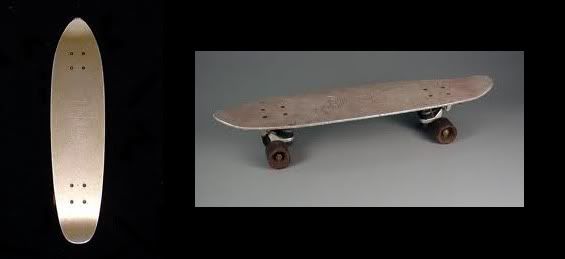
Here, we have the first-ever, twinkick skateboard... the aluminum "Banzai" freestyle board. While most "skateboard scholars" credit the much later World Industries Mike Vallely "Barnyard" model as the first twinkick skateboard on the market, a much more accurate assessment might be that the Barnyard was first "functional, and practical twinkick skateboard". As a heavy, solid lump of aluminum ultimately proved to be neither "functional", nor "practical". And the fuckers killed ya when they smacked your shins, too. I've ridden one... and trust me, it's not exactly "fun". But, it was the first of the many! That much is for certain.
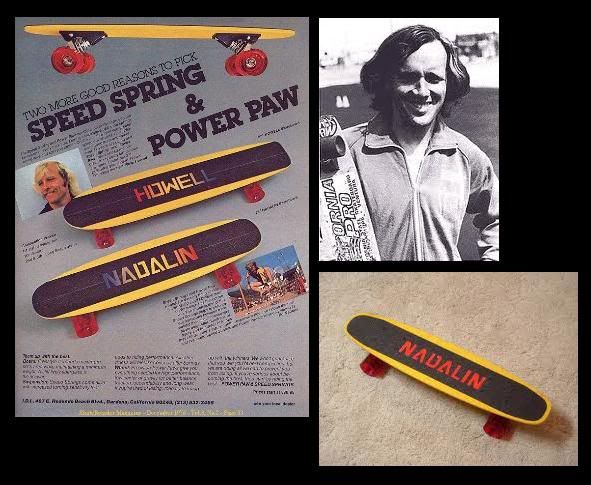
A much more "practical" answer to the freestyle skater, was the Power Paw Ed Nadalin freestyle model. In this composite, we see one of the original ads for the Nadalin (along with a complementary, more "classic" shaped directional board for his teammate, freestyle pioneer Russ Howell), and a close-up of the Nadalin's twin-tip freestyle shape. This shape, combined with the double-kick of the Banzai, was the harbinger of things to come.

This photo is a composite of several photos of classic skateboards featured at the Skull Skates online museum. Here, we have a steel-wheeled, homemade skateboard from the late 1950's; a clay-wheeled skateboard from the early 1960's; and, the Power Paw Ed Nadalin model, circa 1975. Here, we can very clearly see the evolution of freestyle skateboards from simple rectangular planks... to a much more surf-inspired, "curvy" shape... to the semi-blunt, "twin-ish" shape of the Nadalin. While most skateboards of the era built upon the surf-inspired "curved bullet" shape, freestyle wizardry tended to point to the functionality of the double-tailed platform.
This is some of the "raw" footage of the 1975 Del Mar Nationals, which was shot (and thankfully, preserved) by Hal Jepson. This is the contest that was heavily featured in Stacy Peralta's documentary, "Dogtown and Z-Boys" as the place where the Z-Boys solidified their "contest-reputation as skateboarding innovators". Truth be told, the flat and featureless wood platform was a horrible, horrible venue for the Z-Boys to "solidify" anything... given that their expertise was vertical terrain, not featureless horizontal platforms... but, whatever. The story goes that the Z-Boys "destroyed freestyle" by taking the "stand-up, spinning, wheelie-driven paradigm... and smashing it into the ground". Unfortunately for the Z-Boys, history does tend to prove them wrong to some extent... as freestyle's "upright stick people" obviously do continue to move forward and progress their sport, completely unfettered by the Z-Boys' interpretation of "freestyle"...
... as proven by these two clips. The first one is some contest footage that was shot in England, in 1978. The next video- which is a far more "complete" archive- was filmed in 1981... a virtual "dead zone" in our collective history, where most forms of skateboarding dried up, and almost went extinct. Many skateboard companies of the era went out of business, and the sole skateboard magazine (Skateboarder) was on the verge of becoming a much more diversified "action sports" periodical (Action Now) which also covered some lame-ass pursuits such as horseback riding, and BMX. All in all, it was a pretty sad state of affairs for skateboarding. Yet through it all, Del Mar's "stick people" survived... maybe even "flourished", as we can see skateboarding moving from being a "Californian pastime" to a "Worldwide phenomenon", just based on where the videos were shot at.
In this reel, the subjects are Mark Christensen and Richard Ortiz, who are skating for Pacific Shore Surf Shop in Boulder, Colorado. You can see that "freestyle" is still evolving, and coming into it's own as the "freestyle" that we would all recognize as "Classic '80s Freestyle". And, the spread will continue to all corners of the world, from North Carolina (Reggie Barnes), to Florida (Rodney Mullen), to Sweden (Per Welinder), to France (Pierre Andre), to England (Don Brown), and back to Southern California (Primo Desiderio) before the end of the decade.
Classic contest footage from Vancouver, 1985. The subject: Steve Rocco, who would become heavily influential on the next "wave" of freestylers... notably, the the very young (and, very impressionable) Rodney Mullen, who credits Steve as being one of the smoothest and technically advanced freestylers ever. Here, the "Mullen Influence" is readily apparent in how quick, seamlessly, and effortlessly Steve executes his routine.
Louisville, Kentucky, 1988. "The Greats" of their generation are all lined up, and put on the chopping block at a fairly typical NSA-sanctioned event. Note the lack of spectators: The arena is nearly empty, showing that even in its heyday, freestyle wasn't "widely celebrated". Also note that the producers of the video mis-spelled "Per Welinder", and that the "announcers" really don't have much of a clue regarding what's going on out there on the floor.
Ultimately, it would take a whole new movement- the emerging "streetstyle" scene- for freestyle's numerous and incredibly important contributions to be fully clarified, defined, refined, and taken to "the masses" of skaters, everywhere.
Rodney Mullen, Future Primitive (1986)...
Rodney Mullen, Rubbish Heap, 1989...
And Rodney Mullen, in Plan B's Second Hand Smoke (1995).
If there is any series of video clips that truly illustrate why Rodney Mullen is the living legend that he is... these three clips will do it. Compare Rodney's skating to any of his "generational peers", and you'll see real quick that Rodney was light-years ahead of everybody. The reason? Rodney lived an incredibly solitary, almost hermit-like existence that allowed him to focus almost exclusively on his "craft" (as Mike Vallely so eloquently puts it, in On Video's Rodney Mullen retrospective), with a bare minimum of deviations and distractions to inhibit his progress.
In Rubbish Heap, we can also see the first shots in Rodney's "defection" to the world of street skating... shots that become a barrage by the time Second Hand Smoke is released six years later. We can largely credit Mike Ternasky (Plan B's founder) for bringing Rodney out of the "free", and into the "street".
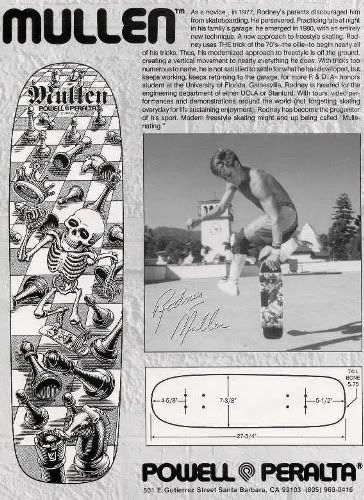
A Powell-Peralta ad for the Rodney Mullen "Chess" model, which was in production between (approx.) 1983- 1987. The outline schematic on the bottom clearly shows how close this shape is to the Ed Nadalin model that we talked about earlier in the article.
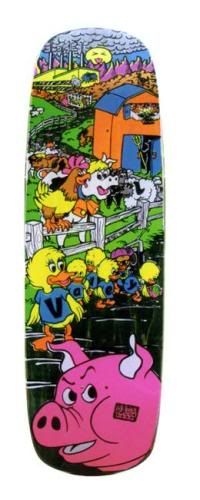
The legandary Mike Vallely "Barnyard" model, circa 1989. Compare it to the Mullen freestyle deck above! As you can see, the Vallely is a bit bigger (nearly 10", instead of about 7.5" for a typical freestyle deck). And, the Vallely has a modern double-kick concave (as opposed to the flat, single-kick profile of a freestyle deck of the era). Still, visually speaking, the obvious fact of the matter is that this Rodney-designed shape is nothing more than a scaled-up freestyle deck, stretched out to "vert" proportions. By bringing it back down to size, we've ended up with the current "popsickle stick" that most of us (but, not all of us!) skate, today.
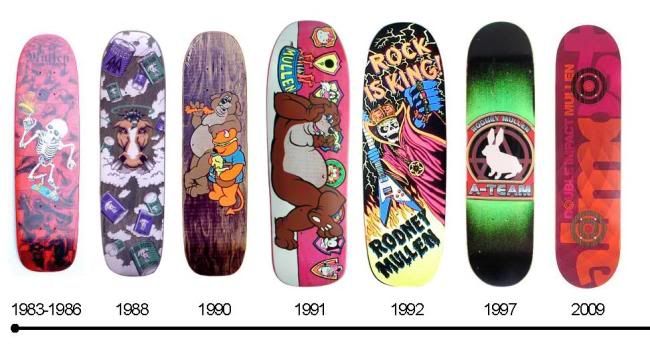
This composite image shows a timeline of Rodney's pro models between 1983, and 2009. It's the best and most direct way to illustrate just how much of an impact freestyle has not only had on the way we skate, but also on what we skate. The Vallely "Barnyard" would roughly coincide with Rodney's first "street" model... but right away, the size starts to come back down to "freestyle size" with most boards measuring in the 7.5" to 8" range.

"The House That Rodney Built" advertisement, Plan B Skateboards, 1992. One of the best testimonials ever created to the vast influence that freestyle has had on the modern street-skating movement. Even today, kids are "inventing" tricks that Rodney (and, his many peers) actually invented in the late 1970's and 1980's. The old cliche still haunts the new generation: If you don't know your history, then you're dooming yourself to repeating it. Not that that would be so bad...!
But still: You'll definitely sound like a kook when you claim that you "invented" something that's actually thirty years old.
Yet, through it all, "classic freestyle" (oftentimes referred to as "Rodney Mullen Freestyle") fails to die. Here, we have footage of "The Next Rodney Mullen", aka Cristobal Bahamonde, circa 2007...
... Kevin Harris for TransWorld SKATEboarding, circa 2008...
...Killian Martin, November 2009...
... and Kevin (again), with euro champion Steffan "Lillis" Akesson, demoing at the Ultra Bowl, August 2010. Supposedly, freestyle has been clinically "dead" since Rodney whittled out his first "street" model way back in 1991... but, the evidence just doesn't support the lie. Truth is, freestyle continues to pick up new practitioners every year. And it won't be long until freestyle returns as a recognized and influential aspect of skateboarding that continually points and paves the way toward the future.

This article would not have been even remotely possible without the following websites, their creators, and the photos, videos, and stories that they've contributed to the world wide web. They include:
Marc McKee, and www.skateboardgraphics.com
PD, and the Skull Skates online museum; www.skullskates.com
Russ Howell, and www.skatewhat.com
YouTube, www.youtube.com (as if we didn't know that already),
and Blair Watson at Skull and Bones, www.skullandbonesskateboards.com/forums.
Thanks to you all for your contributions to preserving and archiving our history. You're good men, and I wish you well.
